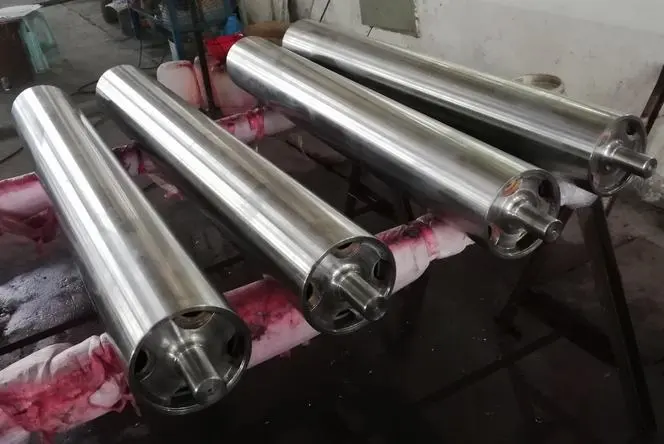The primary KPIs for stabilizer rolls include surface finish quality, dimensional accuracy, balance precision, thermal stability, wear resistance, and operational longevity. A high-quality stabilizer roll should exhibit exceptional surface smoothness to prevent markings or defects on the processed material. Precise dimensional tolerances are essential to ensure uniform pressure distribution across the web. Optimal balance reduces vibration and enhances roll stability during high-speed operations. Thermal stability is crucial for maintaining consistent performance under varying temperature conditions. Superior wear resistance contributes to extended service life and reduced maintenance requirements. Lastly, the operational longevity of a stabilizer roll directly impacts production efficiency and cost-effectiveness.

Surface Finish and Dimensional Accuracy
Surface Roughness Measurement
The surface finish of a stabilizer roll plays a pivotal role in its overall functionality, as a smooth and uniform surface is essential for efficient operation and extended service life. Surface roughness affects the way the stabilizer roll interacts with the material it processes, influencing factors such as friction, wear, and heat generation. In precision industries, including the oil and gas sector, the quality of the surface finish directly correlates to the roll's ability to function smoothly, reducing wear and tear while ensuring optimal efficiency during operations.
To assess surface roughness, a variety of parameters are commonly used, with Ra (arithmetic average roughness) and Rz (mean roughness depth) being among the most prevalent. Ra measures the arithmetic average of the absolute values of surface height deviations over a given sampling length, while Rz is the average of the maximum peak to valley height within a sampling length. Both parameters give essential insights into the uniformity of the surface, but Rz is typically more indicative of larger surface defects or variations. Ra, on the other hand, provides a general indication of the average roughness.
Dimensional Tolerance Control
Maintaining precise dimensional tolerances is crucial for stabilizer rolls to function optimally. Key dimensions include diameter, length, and cylindricity. Tight tolerances ensure uniform pressure distribution and minimize variations in web tension. High-precision measurement tools, such as coordinate measuring machines (CMMs) and laser interferometers, are employed to verify dimensional accuracy during manufacturing and quality control processes.
Roundness and Cylindricity Assessment
The geometric form of a stabilizer roll significantly influences its performance. Roundness and cylindricity are essential attributes that affect the roll's ability to maintain consistent contact with the processed material. Advanced metrology equipment, including roundness testers and form measurement systems, is used to assess these geometric characteristics with high precision.
Balance and Vibration Analysis
Dynamic Balancing Techniques
Proper balance is crucial for stabilizer rolls operating at high speeds. Unbalanced rolls can lead to excessive vibration, reduced product quality, and premature wear of bearings and other components. Dynamic balancing techniques, such as two-plane balancing and multi-plane balancing, are employed to minimize residual unbalance and ensure smooth operation across a wide range of rotational speeds.
Vibration Monitoring Systems
Continuous monitoring of vibration levels is essential for assessing the performance and condition of stabilizer rolls. Advanced vibration monitoring systems utilize accelerometers and sophisticated signal processing algorithms to detect and analyze vibration signatures. These systems can provide early warning of potential issues, allowing for proactive maintenance and preventing unexpected downtime.
Critical Speed Analysis
Understanding the critical speeds of a stabilizer roll is vital for optimizing its performance and preventing resonance-induced vibrations. Finite element analysis (FEA) and experimental modal analysis techniques are used to determine the natural frequencies and mode shapes of the roll structure. This information helps in designing and operating stabilizer rolls to avoid harmful resonance conditions.
Thermal Stability and Wear Resistance
Thermal Imaging and Temperature Control
Maintaining consistent temperature across the stabilizer roll surface is crucial for ensuring uniform material processing. Thermal imaging cameras and infrared thermometers are used to monitor temperature distribution and identify potential hot spots. Advanced cooling systems, including internal coolant circulation and external temperature control units, help maintain optimal thermal stability during operation.
Wear Resistance Evaluation
The wear resistance of stabilizer rolls directly impacts their service life and performance consistency. Various testing methods, such as pin-on-disk tribometry and accelerated wear testing, are employed to evaluate the wear characteristics of roll surface materials. Advanced surface treatments and coatings, including chrome plating, ceramic coatings, and thermal sprayed coatings, can significantly enhance wear resistance and extend operational life.
Surface Hardness and Microstructure Analysis
The surface hardness and microstructure of stabilizer rolls play a crucial role in their wear resistance and overall performance. Hardness testing methods, including Rockwell and Vickers tests, are used to verify surface hardness. Metallographic analysis techniques, such as optical microscopy and scanning electron microscopy (SEM), provide insights into the microstructure and material properties that influence long-term performance.
In conclusion, the key performance indicators for stabilizer rolls encompass a wide range of factors, from surface quality and dimensional accuracy to balance precision and thermal stability. By carefully monitoring and optimizing these KPIs, manufacturers can ensure that their stabilizer rolls deliver consistent, high-quality performance in demanding industrial applications. Regular assessment and maintenance of these critical components contribute to improved product quality, reduced downtime, and enhanced overall production efficiency.
For more information about high-quality stabilizer rolls and custom metal parts for various industries, please contact us at info@welongpost.com. Our team of experienced engineers and professionals is dedicated to providing tailored solutions that meet your specific requirements and help optimize your production processes.



